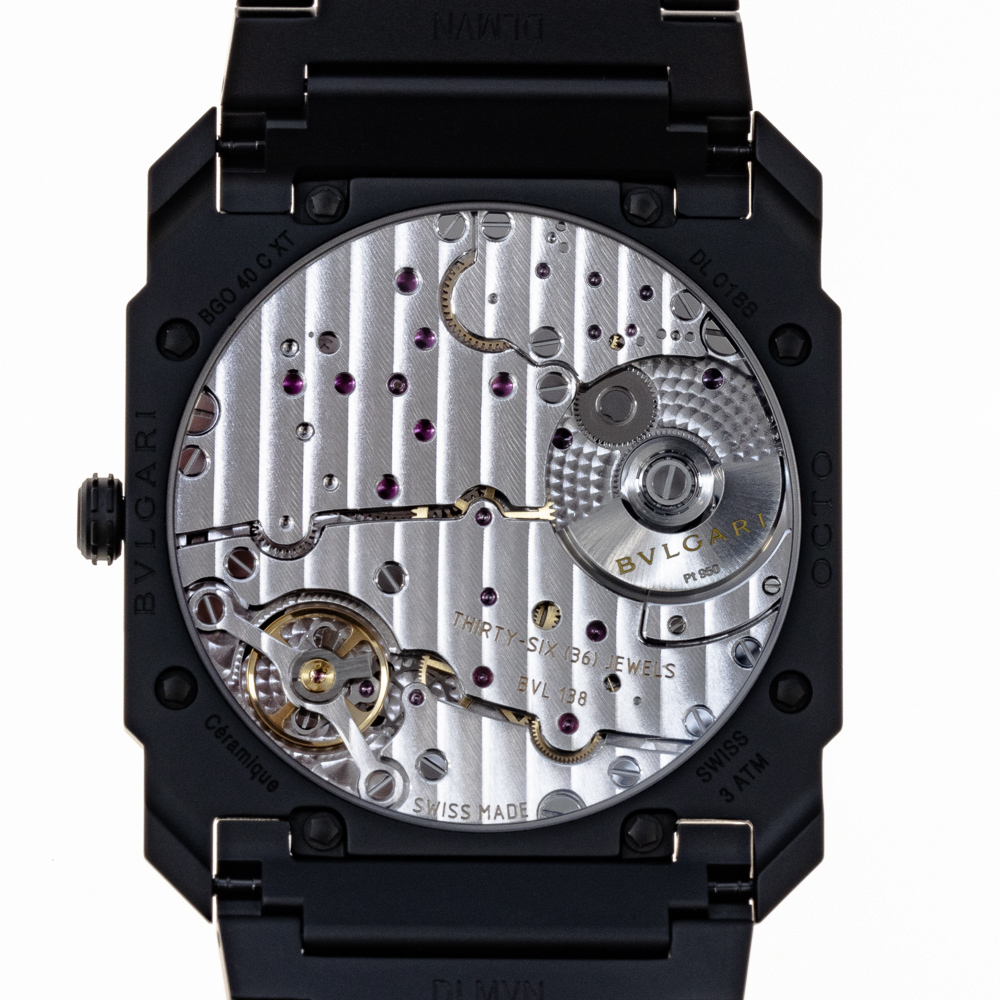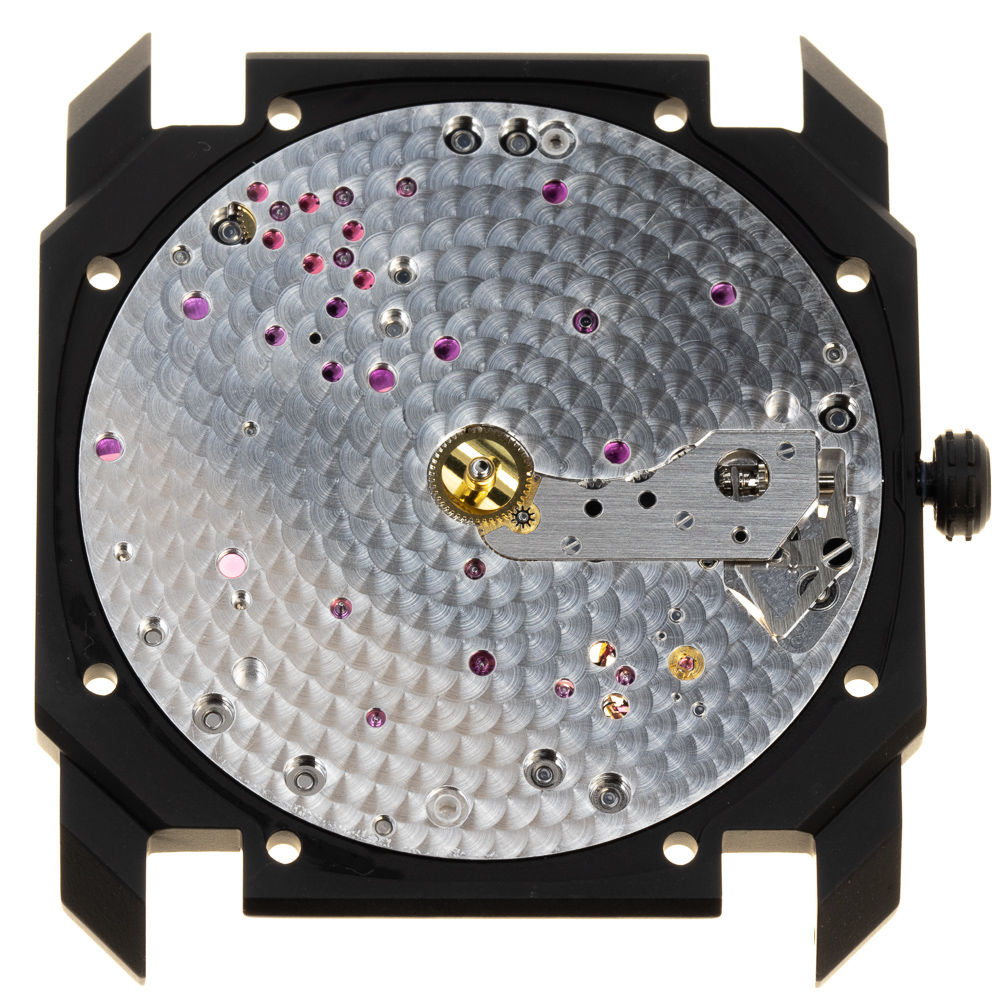The Reason
The slimmest automatic movement to be produced to date (2019), with a ceramic case and integrated bracelet.
The Octo Finissimo Ceramic Automatic is a lightweight, slim timepiece with large diameter calibre. First shown in 2014, the Bulgari Octo Finissimo collection falls into a sector of easily identifiable design DNA's making it a highly recognisable watch.
Total thickness of case 5.5mm & 40mm across flats, water-resistant up to 30 metres. Sapphire case back and front. Octo Finissimo Automatic self-winding calibre, BVL 138 - 2.23mm thick, 36.6mm diameter, 36 jewels. Platinum micro-rotor, small seconds at 7.30 position, 60 hour power reserve.
Please move the cursor across the image below, (or by finger on a smart phone), to rotate the watch.
Profile images with the bracelet removed.
The case back is integrated into the case centre. The 8 pentagonal formed headed screws that traverse the centre are tightened from the rear of the watch pulling the bezel tightly onto it.
The word ceramic in French -Céramique- is engraved onto the case back to associate to the Swiss origins of the watch production.
The bezel with the sapphire glass removed from the watch.
The tubes protruding from the under-side of the bezel align it into the case centre and reinforce the case construction. On the inner side of the tubes is the black rubber ‘O’ ring which renders the join between the two parts water resistant as well as holding in place the movement.
The case back screws are tightened little by little from one to the next to assure there is no deformation of the bezel as it is screwed in place.
The hands are removed with wide headed (spatula-like), sharp hand removing levers.
The indexes and name on the dial are chrome, injected onto the matt black surface.
The hands are polished chrome in order to contrast against the matt black dial.
The ceramic case centre is resistant from scratches and hypoallergenic.
The resulting case in ceramic is 5.5mm thick instead of the titanium version at 5.15mm thick. The material has advantages including lightness and long term consistency in colour however from a manufacturing perspective it is complex to machine due to its hardness.
The BVL138 calibre is 2.23mm thick, 36.60mm in diameter. In total there are 242 components, (excluding the case).
The balance wheel oscillates at a frequency of 3 hertz, (21,600 vibrations/hour).
Included in the 36 jewels set into the calibre are solid domed/bombé shaped jewels which act as security for various wheels, including barrel, reverser blocks and rotor, preventing them from touching the bridges or main-plate.
Geneva stripes (Côtes de Genève)
Spotting (Pearlage)
Click on image to see complete plan.
The platinum rotor rotates on a ceramic ball race, avoiding the need for lubrication and turning more smoothly than on conventional all-steel ball races.
The automatic winding is bi-directional (winding in both directions that the rotor turns).
The small bridge to the right is removed to be able to lift the rotor mass free.
The balance assembly including bridge and the rotor removed.
All surfaces of the calibre, visible and hidden are decorated.
The large steel pinion meshes with the rotor pinion attached to the rotor, winding the watch.
Recto-verso of the rotor weight and its pinion with integrated ceramic ball race.
Instead of a conventional balance cock, the balance is held in place by a bridge traversing it. This makes for a stronger construction accentuating the stability of the movement.
The Swiss lever escapement.
The large escape-wheel bridge removed allowing access to remove the wheel.
The disproportional size of the escape-wheel bridge insures the stability and accuracy of construction when holding the escape-wheel pivot. This design element is repeated through-out the construction and helps overcome the precision, assembly and decoration issues that can be faced when making slim calibres.
The main train bridge removed showing the going-train which transmits power from the barrel to the escapement. Plus the two additional wheels that drive the small seconds hand situated at 7.30 on the dial side.
The automatic bridge removed showing the wheels and reverser blocks (assemblies), that transmit energy from the rotor to the barrel’s ratchet wheel, and winds up the mainspring.
The reverser assemblies allow the rotor to wind the mainspring as it swings in both directions.
In addition to the reversers, a slipping clutch mechanism allows the mainspring to be wound manually, with out damaging the gears found lower in the automatic train.
Recto-verso of the barrel bridge which houses 3 additional domed jewels, that controlling the end shake and diagonal movement of the steel ratchet wheel. Plus 4 more domed jewels that control the large surface of the barrel.
The intermediate steel pinions (and ratchet wheel click) for manual winding are riveted in place with cupped sections in the heads to allow for effective cleaning and lubrication.
A selection of the wheels in the calibre. The smaller yellow wheels are made from Copper Beryllium, the larger for brass then plated after decoration and before the teeth are cut.
The main-plate with the bridges removed.
The setting mechanism with cover plate in place and removed.
Click on image to see complete plan.
Summary
Most modern watch designs are based on models that originated between the 30s-50s. There are very few successful original designs on the market and to produce a timepiece with a strong identity that is a commercial success, is no easy task.
This timepiece is simple in function yet its ultra-slim nature produce a multitude of technical dilemmas to overcome for the constructors, both in the development of the movement and the ceramic case in order to produce a wearable timepiece to be produced in any large quantity.
Aesthetically strong with its own DNA, it is technically well thought out and innovative.
One of the watchmakers tailored movement holders used to support the calibre whilst being assembled.
Diverse images of the finished watch.
To learn more www.bulgari.com
















































